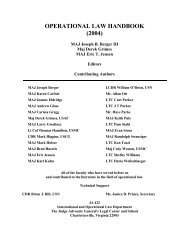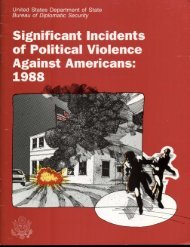- Page 3:
INTERNATIONAL AND OPERATIONAL LAW D
- Page 6:
HRAnnex to Hague Convention No. IV
- Page 10 and 11:
2. War versus Armed Conflict. Histo
- Page 12 and 13:
1. Jus ad Bellum: Legitimate War. L
- Page 15 and 16:
c. The intention must be the advanc
- Page 17 and 18:
. EXAMPLE: National leaders began t
- Page 19 and 20:
1. Early Charter Period. Immediatel
- Page 21 and 22:
CHAPTER 2THE UNITED NATIONS AND LEG
- Page 23 and 24:
C. Secretariat.collective security
- Page 25 and 26:
c. Note that the prohibition refers
- Page 27 and 28:
(ii)(iii)Blockade;Land, sea or air
- Page 29 and 30:
c. “Inherent right” of self def
- Page 31 and 32:
1. History, background and purpose.
- Page 33 and 34:
CHAPTER 3LEGAL FRAMEWORK OF THE LAW
- Page 35 and 36:
(1) GW: Wounded and Sick in the Fie
- Page 37 and 38:
1. Common Article 2 -- Internationa
- Page 39 and 40:
. Providing for the interjection of
- Page 41 and 42:
B. Protecting Power. This refers to
- Page 43 and 44:
APPENDIX ACONFLICT SPECTRUMInternal
- Page 45 and 46:
(as defined in subsection 3.2., bel
- Page 47 and 48:
5.5.2. Ensure that programs are imp
- Page 49 and 50:
eport, established in Joint Pub 1-0
- Page 51 and 52:
APPENDIX CIMPLEMENTATION OF THE DOD
- Page 53 and 54:
(c) The Director for Operations (J-
- Page 55 and 56:
1. Conducting appropriate prelimina
- Page 57 and 58:
CHAPTER 4THE 1949 GENEVA CONVENTION
- Page 59 and 60:
B. Civilians.1. Not expressly cover
- Page 61 and 62:
. The second prohibition was design
- Page 63 and 64:
Conqueror did not assist the shipwr
- Page 65 and 66:
H. Voluntary Participation of Local
- Page 67 and 68:
1,000 PWs. Those not required will
- Page 69 and 70:
(1) In Afghanistan, the Soviets eng
- Page 71 and 72:
. Exception - “in case of urgent
- Page 73 and 74:
(2) Medical aircraft (and vehicles)
- Page 75 and 76:
1. Red Cross. The distinctive emble
- Page 77 and 78:
CHAPTER 5PRISONERS OF WAR AND DETAI
- Page 79 and 80:
of attrition and EPW exchanges did
- Page 81 and 82:
K. 1977 Additional Protocols to the
- Page 83 and 84:
matter where they were located, bec
- Page 85 and 86:
and to be commanded by a person res
- Page 87 and 88:
(2) The standard of proof is “pre
- Page 89 and 90:
. Implied - type of mission.c. Inhe
- Page 91 and 92:
actions were perpetrated by the ene
- Page 93 and 94: D. Transfer of POWs (Art. 46 - 48,
- Page 95 and 96: H. Escape.(1) Military Commissions.
- Page 97 and 98: a. CW2 Hall incident 91(1) Probable
- Page 99 and 100: 2. But can be punitive by analogy u
- Page 101 and 102: 1 See WILLIAM FLORY, PRISONERS OF W
- Page 103 and 104: 25 See BARRY E. CARTER AND PHILLIP
- Page 105 and 106: to the rear. EPWs can be on the mov
- Page 107 and 108: 63 See Ministry of Defence, United
- Page 109 and 110: 78 See Art. 40 & 51, GCC for an ana
- Page 111 and 112: 97 See Scott R. Morris, America’s
- Page 113 and 114: R 27-13APPENDIXUNITED STATES CENTRA
- Page 115 and 116: R 27-13c. The GPW provides that any
- Page 117 and 118: R 27-13g. The servicing judge advoc
- Page 119 and 120: R 27-13particular where such person
- Page 121 and 122: R 27-13APPENDIX CTRIBUNAL PROCEDURE
- Page 123 and 124: R 27-13d. Voting. The decisions of
- Page 125 and 126: R 27-13APPENDIX DREPORT OF TRIBUNAL
- Page 127 and 128: R 27-13APPENDIX EFORM OF OATH FOR A
- Page 129 and 130: R 27-13(That you have committed a b
- Page 131 and 132: CHAPTER 6PROTECTION OF CIVILIANS DU
- Page 133 and 134: targeting method) benefit from rest
- Page 135 and 136: c. The result: Protocol I. The prim
- Page 137 and 138: actual harm to the personnel and eq
- Page 139 and 140: principle common to all four Geneva
- Page 141 and 142: . In addition to providing for the
- Page 143: (1) Attacks not directed as a speci
- Page 147 and 148: (1) Invader has rendered the invade
- Page 149 and 150: 2. SPECIFIC PROTECTIONS - LOCATION
- Page 151 and 152: (i)Can only be compelled to work to
- Page 153 and 154: 244. TREATMENT OF PROPERTY DURING O
- Page 155 and 156: territory the civilian loses his st
- Page 157 and 158: CHAPTER 7METHODS AND MEANS OF WARFA
- Page 159 and 160: 5. The U.S. specifically objects to
- Page 161 and 162: Army Pamphlet 27-161-2, 12 (1962) [
- Page 163 and 164: above, GP I, Article 51(5) describe
- Page 165 and 166: . Geneva Convention Definition. (GP
- Page 167 and 168: on a hostile mission. Parachutists,
- Page 169 and 170: natural environment against long-te
- Page 171 and 172: (2) Enemy has duty to indicate pres
- Page 173 and 174: 2. Weapons may be illegal:a. Per se
- Page 175 and 176: 2. Booby Traps. Definition: A devic
- Page 177 and 178: 6. U.S. Developments. On 17 Septemb
- Page 179 and 180: (1) Article I. Parties agree to nev
- Page 181 and 182: (2) The Senate’s resolution of ad
- Page 183 and 184: 2. Land Warfare. Creation of fictit
- Page 185 and 186: 2. Feigning and Misuse. Distinguish
- Page 187 and 188: proceeded to capture French Peaceke
- Page 189 and 190: A. PrinciplesB. TargetsC. WeaponsD.
- Page 191 and 192: CHAPTER 8WAR CRIMES AND COMMAND RES
- Page 193 and 194: in many codes of chivalry, rape was
- Page 195 and 196:
3. Panama. In a much-publicized cas
- Page 197 and 198:
e. Since its inception, 94 individu
- Page 199 and 200:
(15) Vladimir Santic, 14 January 20
- Page 201 and 202:
consents. This dual system of conse
- Page 203 and 204:
3. Crimes Against Humanity. A colle
- Page 205 and 206:
national, ethnic, racial, or religi
- Page 207 and 208:
was purely internal. The court conc
- Page 209 and 210:
1. Genocide. “For the purpose of
- Page 211 and 212:
D. Army Policy. “The commander is
- Page 213 and 214:
A. International v. Domestic Crimes
- Page 215 and 216:
C. The Choice of Forum(c) Violation
- Page 217 and 218:
(i)Cf. Yamashita, 327 U.S. 22 (cons
- Page 219 and 220:
inevitable. No Court will punish a
- Page 221 and 222:
j. International Criminal Court. Th
- Page 223 and 224:
2. As discussed below, Congress has
- Page 225 and 226:
6. Using authority derived from sta
- Page 227 and 228:
CHAPTER 9THE LAW OF WAR AND MILITAR
- Page 229 and 230:
conflict, but place soldiers in sit
- Page 231 and 232:
(3) This situation results in a vac
- Page 233 and 234:
C. JA’s must ensure that Rules of
- Page 235 and 236:
7. If captured, these personnel are
- Page 237 and 238:
(3) Relationship between Humanitari
- Page 239 and 240:
(1) The Universal Declaration of Hu
- Page 241 and 242:
(1) Attempt to identify those count
- Page 243 and 244:
(1) Extraterritoriality. Although t
- Page 245 and 246:
(2) The significance of applying su
- Page 247 and 248:
collection, burial, and accountabil
- Page 249 and 250:
2. Detainment is Typically Authoriz
- Page 251 and 252:
(6) Categorization and Segregation.
- Page 253 and 254:
L. Detainees retain all the civil r
- Page 255 and 256:
occupied territory. Accordingly, if
- Page 257 and 258:
APPENDIX CCPL AND DISPLACED PERSONS
- Page 259 and 260:
. Application conditioned upon posi
- Page 261 and 262:
safety of the requester against imm
- Page 263 and 264:
CHAPTER 10LAW OF WAR: METHODS OF IN
- Page 265 and 266:
E. Reducing The Credibility Gap. Th
- Page 267 and 268:
Thereafter, judge advocates should
- Page 269 and 270:
where soldiers are walked through t
- Page 271 and 272:
B. Be Enthusiastic - Be an Obvious
- Page 273 and 274:
. Violations of the Law of War Freq
- Page 275 and 276:
3. “If we are on a sensitive miss
- Page 277 and 278:
periodic review and evaluation, par
- Page 279 and 280:
action) designed to discourage this
- Page 281 and 282:
eviewing ROE, to ensure that miscon
- Page 283 and 284:
from a Dum Dum would be the same or
- Page 285 and 286:
APPENDIX BEXTRACT FROM AR 3504-41,
















